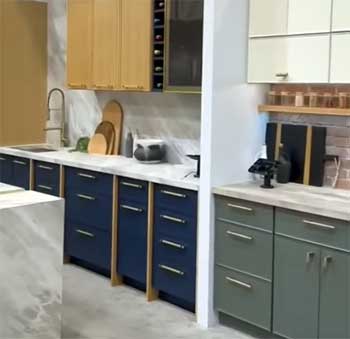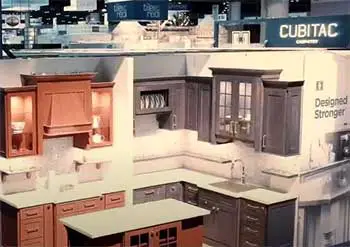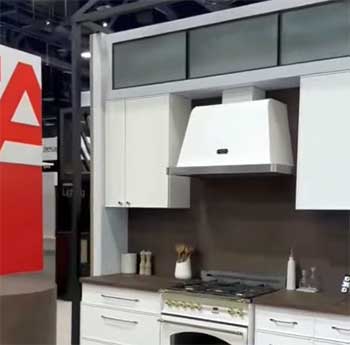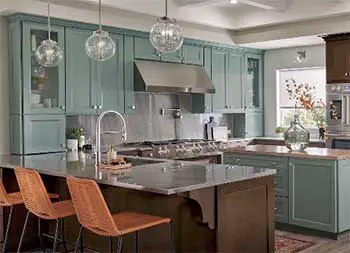When I decided to remodel my kitchen, I wanted cabinets that could balance style, durability, and affordability without feeling like I was settling for less.
After weeks of research, showroom visits, and late-night scrolling through reviews, I landed on Cubitac Cabinetry—and let me tell you, I haven’t looked back. These cabinets bring a modern flair, solid construction, and a price tag that doesn’t make your wallet weep.
If you’re hunting for cabinets that deliver on quality and aesthetics while staying budget-friendly, Cubitac is a name you need to know. Trust me, your kitchen deserves this upgrade.
My Journey With Cubitac Cabinets

Picture this: my old kitchen was a mishmash of chipped laminate cabinets and creaky hinges that screamed “replace me!”
I wanted a space that felt fresh, functional, and like it belonged in a magazine—without spending a fortune.
Enter Cubitac Cabinetry. I first stumbled across them at a local showroom, where their sleek Madison Midnight cabinets caught my eye.
The deep, moody finish and clean lines felt like they were calling my name.
I spent hours flipping through their catalog, marveling at the variety of styles, from classic shaker to minimalist slab doors, and the range of finishes, from crisp whites to rich wood tones.
What sold me was the hands-on experience. I ordered a sample of their Dover Latte in a satin finish, and when it arrived, I was impressed by the weight and craftsmanship.
The solid birch construction felt sturdy, not like the flimsy particleboard I’d seen in some budget brands. Installation was a breeze, too—most of their cabinets come preassembled, which saved me from the headache of puzzling together ready-to-assemble (RTA) pieces.
My contractor raved about the ease of fitting them into my kitchen layout, and I loved how the soft-close hinges and drawers glided smoothly, adding a touch of luxury to my everyday routine.
The real test came after a few months of use. My kitchen gets a lot of action—spaghetti sauce splatters, sticky toddler hands, you name it. Yet, Cubitac’s finishes held up beautifully, resisting scratches and stains better than I expected.
The cabinets transformed my space into a modern, inviting hub where I now love hosting friends and family. Sure, they’re not perfect (more on that later), but my experience with Cubitac has been overwhelmingly positive.
They’ve made my kitchen a place I’m proud to show off, and I’m excited to share why they might be the right choice for you, too.
The Pros of Choosing Cubitac Cabinets
- Affordability Without Sacrificing Style

One of the biggest reasons I chose Cubitac was the price.
These cabinets sit comfortably in the mid-market tier, offering a sweet spot between budget-friendly stock cabinets and pricier custom options.
I paid significantly less than I would have for premium brands, yet the sleek designs and modern finishes made my kitchen feel high-end.
Whether you’re eyeing a classic shaker style or a bold, contemporary slab door, Cubitac’s range of colors and finishes lets you create a space that feels custom without the custom price tag. For me, this was a game-changer—I got the look I wanted without draining my savings.
- Durable Construction for Everyday Life
I’m tough on my kitchen, and Cubitac’s cabinets have proven they can handle it. Most of their lines use solid birch for door fronts and plywood for the cabinet boxes, which gives them a sturdy feel that stands up to daily wear and tear.
Unlike some cheaper brands that rely on particleboard, Cubitac’s materials resist moisture and warping better, which is a must if you’re cooking up a storm or dealing with humid climates.
The dovetail joints on the drawers and the optional Blum soft-close hardware add a level of durability and smoothness that makes every interaction feel premium. After months of heavy use, my cabinets still look and function like they did on day one.
- Easy Installation for Stress-Free Remodels
As someone who’s not exactly a DIY guru, I was thrilled with how straightforward Cubitac’s installation process was. Most of their cabinets come preassembled, which saved my contractor time and me money.
Even if you’re going the RTA route, the instructions are clear, and the pieces fit together like a dream. The cabinets are designed with standard sizing, so they slotted into my kitchen layout without needing major tweaks.
For anyone tackling a remodel, this ease of installation means less time stressing over logistics and more time enjoying your new space.
- Wide Range of Design Options
Cubitac’s variety is a huge win for anyone who wants flexibility. I was torn between their Madison Latte for a crisp, timeless look and the darker Madison Midnight for a bold, modern vibe.
They offer everything from warm wood tones to sleek lacquer finishes, so you can tailor your kitchen to your exact taste. The ability to mix and match colors—like white uppers with gray lowers—gave me the freedom to get creative.
Plus, their catalogs include thoughtful touches like built-in organizers and pull-out trays, which made my kitchen as functional as it is beautiful.
The Cons of Cubitac Cabinets
- Limited Customization Compared to Premium Brands

While Cubitac offers plenty of style and color options, they don’t match the customization level of high-end brands.
If you’re dreaming of cabinets tailored to the exact inch or unique finishes like hand-distressed textures, you might find Cubitac’s stock and semi-custom options a bit restrictive.
For me, this wasn’t a dealbreaker—my kitchen layout worked well with their standard sizes—but if you have an unconventional space or highly specific design needs, you might need to look elsewhere or make compromises.
- Occasional Quality Control Hiccups
I’ve been lucky with my Cubitac cabinets, but I’ve heard from others who’ve had minor issues, like scratches on door fronts or slight misalignments in delivery. In my case, one cabinet arrived with a small nick, but Cubitac’s customer service was quick to send a replacement.
These hiccups seem rare, but they’re worth noting if you’re ordering a large batch. Inspecting your order upon delivery is a must to catch any issues early. Their 5-year limited warranty offers some peace of mind, but it’s not as comprehensive as some premium brands.
- Less Brand Recognition
Cubitac isn’t as well-known as some of the big players in the cabinet world, which can make it harder to find reviews or showroom displays. When I was researching, I had to dig a bit to find real user feedback, and not every kitchen showroom carried their products.
This lack of visibility might make you hesitate if you prefer brands with a more established reputation. For me, the quality and price outweighed this, but it’s something to consider if brand name matters to you.
Maintenance Tips For Keeping Cubitac Cabinets Pristine
- Regular Cleaning to Preserve the Finish
Keeping your Cubitac cabinets looking fresh is all about consistency. I clean mine weekly with a soft, damp cloth and a mild dish soap solution to remove grease and fingerprints. Avoid harsh chemicals or abrasive sponges—they can dull the finish or scratch the surface.
For painted finishes like my Dover Latte, I’m extra gentle to prevent chipping. After wiping, I dry the surface with a microfiber cloth to avoid water spots. This quick routine keeps my cabinets gleaming and prevents buildup from cooking splatters or sticky hands.
- Protecting Against Heat and Moisture
Kitchens are tough environments, with steam, spills, and heat constantly testing your cabinets. I’ve learned to be mindful of where I place hot pots or appliances near my Cubitac cabinets, especially since some finishes, like thermofoil, can be sensitive to high heat.
Using trivets and keeping a dehumidifier in humid climates helps prevent warping or peeling. If you’re installing Cubitac cabinets near a professional-grade range, consider adding a heat shield to protect the doors.
These small steps go a long way in maintaining the cabinets’ longevity.
- Tightening Hardware for Smooth Operation
The soft-close hinges and drawers on my Cubitac cabinets are a dream, but they need occasional TLC to stay smooth. Every few months, I check the screws on the hinges and drawer tracks to ensure they’re tight.
A simple screwdriver does the trick, and it prevents wobbly doors or sticky drawers. If you notice any squeaking, a drop of lubricant on the hinges works wonders. This quick maintenance habit keeps your cabinets functioning as smoothly as they did on installation day.
- Addressing Scratches and Nicks Promptly
Even durable cabinets like Cubitac’s aren’t immune to the occasional scratch or nick. When I noticed a small scuff on one of my cabinet doors, I used a touch-up kit from Cubitac to fix it. For minor scratches, a color-matched furniture marker can blend the damage seamlessly.
If you’re dealing with a deeper gouge, contact Cubitac’s customer service for a replacement part or advice. Acting quickly prevents small imperfections from becoming bigger headaches and keeps your kitchen looking polished.
Comparing Cubitac To Other Cabinet Brands
When I was choosing cabinets for my kitchen remodel, I spent a lot of time comparing Cubitac to other brands like Bellmont, KraftMaid, and Schrock. Each has its strengths, but I wanted to see how they stacked up against Cubitac in terms of quality, price, design options, and overall value.
Here’s my take on how Cubitac holds its own in a head-to-head comparison, written from my experience as a homeowner looking for the perfect balance of style and affordability.
- Cubitac Vs. Bellmont Cabinets

When I first looked at Bellmont Cabinets, their 1900 series with high-gloss laminate finishes grabbed my attention.
They have a sleek, modern vibe that’s perfect for contemporary kitchens, and their frameless construction offers a clean, European-style look.
However, when I compared them to Cubitac, I noticed some key differences.
Bellmont’s pricing is noticeably higher—often 20-30% more than Cubitac for similar styles.
While Bellmont offers solid plywood construction, I heard from other users about occasional quality control issues, like scratches or chips on delivery, which made me wary.
Cubitac, on the other hand, impressed me with its reliable plywood boxes and solid birch doors, and my order arrived with only a minor nick that their customer service quickly resolved. Cubitac also offers a wider range of finishes, from matte to satin, which gave me more flexibility to match my kitchen’s vibe.
For me, Cubitac’s affordability and consistent quality edged out Bellmont, especially since I didn’t need the ultra-modern frameless look.
- Cubitac Vs. KraftMaid Cabinets

KraftMaid was a serious contender when I was shopping, thanks to its reputation for semi-custom and custom cabinets.
Their ability to tailor sizes down to the inch and offer unique finishes, like hand-distressed wood, was tempting for my dream kitchen.
But when I got quotes, KraftMaid’s prices were a shock—nearly double what I paid for Cubitac’s Madison Midnight cabinets. Both brands use solid wood doors and offer plywood upgrades, but KraftMaid’s premium features come at a steep cost.
Cubitac’s preassembled cabinets and soft-close hardware gave me a similar high-end feel without the budget-busting price tag. KraftMaid’s customization is a big draw if you have an odd-shaped kitchen or want bespoke details, but for my standard layout, Cubitac’s stock and semi-custom options were more than enough.
I also found Cubitac’s color range, like their Dover Latte, more modern and varied than KraftMaid’s somewhat traditional palette. For value-driven buyers like me, Cubitac delivered comparable quality at a fraction of the cost.
- Cubitac Vs. Schrock Cabinets

Schrock Cabinets caught my eye with their reputation for durability and a wide range of door styles, from classic to contemporary. Like Cubitac, Schrock uses solid wood for doors and offers plywood boxes, which made the quality feel similar.
However, Schrock’s pricing leans closer to KraftMaid’s, often 25-40% higher than Cubitac, especially when you add upgrades like soft-close hinges or custom sizes. Schrock’s lead times were also longer in my research—sometimes 6-8 weeks compared to Cubitac’s 2-4 weeks for delivery.
I loved Schrock’s Entra series for its frameless, modern look, but Cubitac’s framed cabinets, like the Madison line, offered a similar aesthetic with better affordability. Cubitac’s preassembled cabinets were a huge plus for my contractor, saving us installation time, while Schrock’s assembly process felt more involved.
Both brands have strong warranties, but Cubitac’s 5-year coverage felt sufficient for my needs. Ultimately, Cubitac won me over with its lower price and faster delivery without sacrificing the sturdy construction or style I wanted.
Also Read: Are Waypoint Cabinets Worth It?
Frequently Asked Questions (FAQ)
From my experience, Cubitac is a solid choice for anyone looking to balance quality, style, and affordability. Their cabinets are well-constructed with plywood boxes, solid wood doors, and features like soft-close hinges that rival more expensive brands. They’ve held up beautifully in my kitchen, handling daily messes without losing their charm. While they may not have the prestige of premium brands, their value and durability make them a great option for most homeowners. If you’re on a budget but want a modern, sturdy kitchen, Cubitac is absolutely worth considering.
Cubitac cabinets are designed and headquartered in Ridgefield, New Jersey, but they use a blend of domestic and globally sourced materials. The company leverages international manufacturing to keep costs down, with many components crafted in places like Vietnam or Mexico before being assembled in the U.S. This approach allows them to offer high-quality cabinets at competitive prices. My cabinets arrived preassembled, and the craftsmanship felt consistent with what I’d expect from a U.S.-based brand, even with the global sourcing.
It’s tough to crown one brand as the absolute best since it depends on your needs and budget. In my research, Fabuwood consistently gets high marks for its balance of quality, affordability, and reliable delivery, making it a top contender in the mid-market tier. Premium brands like KraftMaid or Wellborn often lead for customization and high-end finishes but come with a steeper price. For me, Cubitac hit the sweet spot—comparable quality to Fabuwood but slightly cheaper with more color options. Your best bet is to prioritize construction quality and design fit over brand name.
When I was shopping, I learned a few key things to look for in high-quality cabinets. First, check the materials—plywood boxes and solid wood doors, like Cubitac’s, are more durable than particleboard or MDF. Look for dovetail joints in drawers and sturdy hardware, like Blum soft-close hinges, which add longevity and smoothness. Inspect the finish for even application and resistance to scratches or moisture. Finally, ensure the cabinets are preassembled or have clear instructions to avoid flimsy construction. Testing a sample door, as I did with Cubitac, can also give you a feel for the craftsmanship before committing.
Why Cubitac Cabinets Are Worth Your Investment?
After transforming my kitchen with Cubitac cabinets, I can confidently say they’re a fantastic choice for anyone seeking style, durability, and value. From their sleek designs to their sturdy construction, they’ve made my space a functional and beautiful hub for my family.
Whether you’re a busy home cook or just want a kitchen that wows, Cubitac delivers without breaking the bank. If you’re ready to elevate your kitchen, I urge you to give Cubitac a serious look—you won’t be disappointed.
